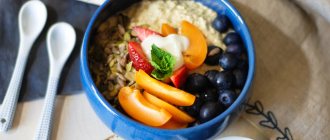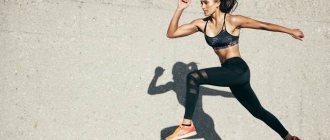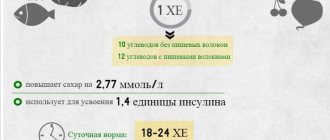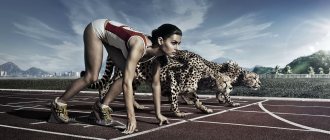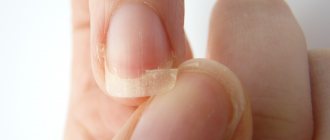In this article we will tell you:
- What are calories
- 4 reasons why you shouldn't count calories
- Description of nutrients
- Energy consumption formula
- Is it possible to lose weight without counting calories?
- 3 Interesting Experiments Showing the Benefits of Nutrient Counting
- 3 options for getting out of a situation when you don’t want to count anything
- 5 final tips for losing weight
- The consequences of obsessing over calorie counting
It is generally accepted that you need to know the proportions of BJU (proteins, fats and carbohydrates), and 30 kg will disappear in six months, as if they never happened. But it's not that simple. The calorie content of foods may vary depending on the method of preparation. Calories in one product can vary depending on the cooking method and even the cutting method.
Nutrients are biologically active elements involved in the life of the body. They are divided into microelements (vitamins and minerals) and macroelements (proteins, fats, carbohydrates). There are many of them, and each has its own task in maintaining health. It is enough to identify what the body lacks in order to fill the gaps. In words, everything sounds simple, but in reality there are some nuances that should definitely be taken into account when calculating nutrients.
What are calories
A calorie is a unit of energy. 1 calorie represents the amount of energy that must be expended to heat 1 gram of water by 1 degree Celsius. Energy is usually measured in joules, but when it comes to food and its value, we use a different unit of measurement - the calorie.
At the same time, energy is not only consumed by us, but also spent. If you eat a large amount of high-calorie foods, the energy obtained from them will be used up during physical activity, and the remainder will be stored by the body in the form of subcutaneous fat.
On average, 1 gram of protein (fish, meat) and 1 gram of carbohydrate (cereals) contains approximately 4.1 kcal, and 1 gram of any fat (for example, olive oil) contains about 9.3 kcal.
Obviously, in order to lose weight, you need to consume food of such calorie content and volume that will create an energy deficit in the body. Under such conditions, the body that needs it will begin to spend what it has accumulated from its own resources, including subcutaneous fat and muscles (therefore it is important to give them a load).
When reading food labels, you should understand that the figures presented there are fairly average, calculated without taking into account cooking and energy costs for digestion.
The number of calories in 100 grams of the same product, presented in different forms, may be different. What is this connected with?
- Culinary processing.
Research from Harvard University has shown that cooking foods increases their calorie content.
- Molecular features
. For example, potatoes will have different caloric contents when cold and when hot, this is influenced by resistant starch, which in a cold product serves as food for bacteria.
Interestingly, alcohol contains no proteins, no fats, no carbohydrates, but it does contain calories: there are 7 kcal per 1 gram of pure alcohol.
The food we eat is mostly processed by the digestive organs, but not all of it. In this regard, all people are individual; each of us has a different process of assimilation of food. This depends on the health of the gastrointestinal tract, metabolism, and the method of preparing food.
Water
Weight loss secret 3. According to WHO, at least 80% of diseases are caused by a constant lack of fluid in the body. Water is involved in all metabolic processes. When its quantity is small, salts are concentrated in the cells and between the cells. This leads to the formation of kidney stones, joint diseases, and osteochondrosis.
Water is an assistant in solving many problems that arise when losing weight. The fluid circulatory system nourishes the cells. It also dissolves all simple products after the breakdown of food. Water deficiency leads to weight gain.
After burning fats, toxic substances are formed. To prevent autointoxication when there is a large amount of toxins, the body’s defense systems stop the breakdown of fats. Drinking water helps get rid of waste products, toxins and salts. The process of fat breakdown resumes.
There is no need to pump yourself up with liquid immensely. How do you drink water?
- We are talking about pure still water, not soups and drinks. The morning begins with a glass of warm water.
- There is a statement that you need to drink 8 glasses of water daily. However, everything is individual, people lose moisture in different ways. But you should not drink less than 5 glasses. The color of urine is indicative here. Light yellow color indicates sufficient fluid, dark yellow indicates dehydration.
- We often confuse the feeling of hunger with “why should we eat something tasty?” Water will help here too.
- The main rule: you need to drink water evenly throughout the day. If you don't have such a habit, develop it. You can use a bottle with a bright label that attracts attention, and have water with you in the car.
Description of nutrients
Nutrients are biologically significant elements that the human body needs in order for it to function normally. They are divided into micronutrients and macronutrients. For us, they are indispensable because they are not produced in the body, but enter it along with food. A person can remain healthy only if he receives all the substances he needs on a regular basis.
- Macronutrients
Macronutrients are substances that provide the body with energy. A balanced diet that contains all macronutrients allows the human body to function normally. Thanks to them, the synthesis of hormones, enzymes and other elements occurs, ensuring adequate development and growth of the body.
These include:
- proteins;
- fats;
- carbohydrates.
- Micronutrients
Micronutrients are substances that come with food or special supplements in microdoses.
These include:
- vitamins;
- minerals.
In addition, water is considered a macronutrient. Our body consists of 55-65% water, so it urgently needs it. On average, a person should drink from 1.5 to 2.5 liters of water per day.
Despite the small amounts of micronutrients supplied with food, they have a huge impact on the body, and without them you can easily get a whole bunch of ailments. Let's remember calcium. Deficiency of this mineral underlies 147 diseases. This also applies to other micronutrients.
Thanks to macroelements, we receive the energy needed by cells, tissues and organs. The amount of energy that each person needs is highly individual and depends on the level of physical activity. And also from the work of metabolic reactions and the hormonal system.
To prevent the body from experiencing stress, you need to monitor the quantity and quality of proteins, fats, carbohydrates, as well as vitamins and minerals that come to us from food, that is, it is important to count nutrients, not calories. Their deficiency provokes diseases and all sorts of addictions such as cravings for sweets or fatty foods.
Physical activity
Weight loss secret 4. There are no pills or potions that burn fat. It is burned in the firebox. The firebox is a muscle. The muscle becomes a firebox when it is loaded with work.
For obese people, walking in the fresh air or walking on an indoor treadmill is recommended.
You need to study systematically, and not from time to time. Choose comfortable sports shoes. The walking pace should not cause shortness of breath. A morning walk of one hour before breakfast is optimal. It is advisable to take 10,000-14,000 steps daily. A pedometer or smartphone app will help here. If the excess weight is not too much, 6-8 kg, then you can combine cardio and strength exercises. At the same time, you lose weight and improve your figure.
Training scheme:
- 15 minutes of cardio training (elliptical, treadmill, exercise bike) with a moderate intensity load;
- 40 minutes of strength training exercises aimed at specific muscle groups;
- 15 minutes of cardio training again, as at the beginning of the workout; Stretching while the muscles are warm.
While walking or working out in the gym, you can drink water in small sips, because there is a lot of moisture loss.
Effective weight loss is only possible with a balanced diet and physical activity.
Energy consumption formula
The interaction in the human body between incoming and expended energy can be expressed by the following formula:
Energy balance (Eb) = Energy that was received (Ep) – Energy that was expended (Er)
or
Eb = Ep - Er
Let's look at these 3 components in more detail.
- The Energy That Came In (Ep)
The only source of energy for the body is food, namely: proteins, fats and carbohydrates.
However, not all food is absorbed in the human body. It depends on the degree and method of cooking, on how thoroughly a person chews, how correctly his digestive enzymes work, etc.
We recommend
“Body detox: how to do it correctly” Read more
The BJUs that were nevertheless mastered are distributed as follows:
- 1 gram of protein gives 4 kcal when broken down
- 1 gram of carbohydrates – 4 kcal
- 1 gram of fat – 7.5 kcal
- 1 gram of alcohol – 7 kcal
These energy sources are in our formula Ep.
- What is energy spent on (Er)
After food has been digested and nutrients have been absorbed, they are broken down to produce energy, which is either used by the body to perform various tasks or stored.
There are three main items of human energy expenditure:
- The cost of maintaining life is basal metabolism.
- Digestion costs.
- Expenditures on physical activity, which is divided into training and non-training.
Energy consumption to maintain life is the largest and amounts to approximately 60-70% of all energy entering the human body. This energy is spent, for example, on breathing, blood circulation, maintaining body temperature, cell growth and regeneration.
Digestive expenditure is the amount of energy the body needs to digest incoming food. This is the second largest item of energy expenditure and accounts for 10-20%.
Finally, the third part of energy expenditure is the expenditure on maintaining activity (mental, physical).
To calculate the number of calories needed per day, several formulas are used, the most popular of which is the MifflinSt formula. Jeor. It looks like this:
Physical activity rate:
1 – low physical activity;
1.3 – average physical activity;
1.5 – high physical activity.
Example
: woman, 32 years old, 54 kg, height 167 cm, average physical activity.
Daily calorie intake = (54*10 + 167*6.25 – 32*5-161)*1.3 = 1641 kcal per day.
Is it possible to lose weight without counting calories?
Yes of course. However, this requires so-called metabolic flexibility, that is, the body’s ability to easily switch from one energy source to another, while effectively using the one that is available. In addition, it is the ability to quickly destroy fat reserves without stress and hunger.
What happens if your body does not have this quality, or rather the entire metabolic process is disrupted:
- the body has fat reserves, but they are not burned due to frequent feelings of hunger;
- Frequent consumption of carbohydrates leads to a lot of glucose in the blood, which the body is unable to get rid of, and this leads to serious fluctuations in sugar levels;
- The fats eaten are stored by the body, which cannot burn them.
To understand how flexible your metabolism is, answer two questions:
- Can I live without snacking for more than three hours?
- Does the weight come off quickly when I put effort into it?
If the answer to both questions is “no,” you probably have problems with your metabolism.
With a balanced diet, a person may not think about snacking for up to 5-6 hours between meals. At this time, the level of insulin, which increases when eating, returns to normal, and the body begins to fight fat reserves, which is facilitated by glucagon.
If you want to lose weight, try eating minimally processed foods. This happens for the following reasons:
- The body spends more energy on chewing and digesting coarsely cut and unheated food.
- Based on its molecular structure, raw food is healthier. For example, the glycemic index of raw beets is 30 units, boiled or baked – 65 units.
- The longer you chew your food, the stronger the signal to your brain that your body is full.
Avoid processed meats and potatoes
pixabay.com
The 2011 Changes in Diet and Lifestyle and Long-Term Weight Gain in Women and Men study showed which foods are associated with weight gain. Over four years, people who consumed potato chips, potatoes, sugary drinks and processed meats gained an average of 1.3 kilograms. Eating vegetables, whole grains, fruits and nuts helped me lose weight.
Since potatoes are a fairly high-calorie food with a high glycemic index, it is better to exclude them from your diet altogether.
A 2015 study of Potato consumption as high glycemic index food, blood pressure, and body mass index among Iranian adolescent girls found that among adolescent girls who consumed potatoes more than once a week, there were significantly more cases of obesity and overweight than among those who ate potatoes less often. Scientists have concluded that potato consumption increases body mass index and waist circumference.
Also exclude processed meats: sausages, sausages, bacon and other products for which the meat has been salted, smoked or canned. Skip canned vegetables and legumes in favor of fresh or frozen ones.
The consequences of obsessing over calorie counting
Constantly thinking about the caloric content of foods can lead you to orthorexia - a nervous disorder, which consists precisely in the fact that a person becomes fixated on counting these numbers and eating right. And any stress means increased cortisol and difficulty losing weight. Do you want to become slim? Keep calm!
It is impossible to calculate everything, and each organism has its own needs. Genes, hormonal levels, metabolism, the state of the microbiome - all this affects the absorption of food. Just strive for the right diet without complex calculations and exercise at your own pace.
Of course, if you're just starting out on your nutrition journey, it makes sense to count nutrients and calories to understand the system. But you will quickly figure out what’s what, and there will be no need to deal with it further. Over time, it will become clear which foods and in what volumes provide saturation, energy and lightness in the body.
Don't forget that the basis of proper nutrition is its variety. Eating boiled breast and cucumber is not bad in itself, but not every day. Approach the process of losing weight and healing your body prepared, study which foods are healthy and which are undesirable to consume, remove the empty calories that we talked about at the beginning of the article, and act consciously.
Now let's take a closer look at each part
Vegetables
It turns out that half of the diet consists of vegetables. They are low in calories and rich in vitamins. And most importantly, they contain fiber, which is necessary for the health of the gastrointestinal tract. Fiber also helps with weight loss by removing toxins from the body. Paradoxically, it is fiber that modern people most often lack.
Vegetables in almost any form are appropriate on our plate - except fried in oil. That is, it can be slices and salads from fresh vegetables, stewed, boiled, steamed or grilled.
There is an exception here - potatoes and legumes. Potatoes are rich in carbohydrates, and legumes belong on the protein side of the plate.
Greens are also vegetables, so generously decorate your dishes with parsley - this makes the plate look more appetizing.
Squirrels
These are building materials for our muscles. You need them even if you're not building muscle.
Here you can place meat (preferably white), fish and seafood, eggs and cottage cheese. Vegetarians can safely place legumes and soy products.
Carbohydrates
It is the fuel for our lives on all levels. Complex carbohydrates take longer to digest and provide the necessary energy gradually - this time is just enough until the next meal.
Place on this part of the plate various ready-made cereals (buckwheat, rice, bulgur), durum wheat pasta, whole grain bread or potatoes (boiled or baked).


